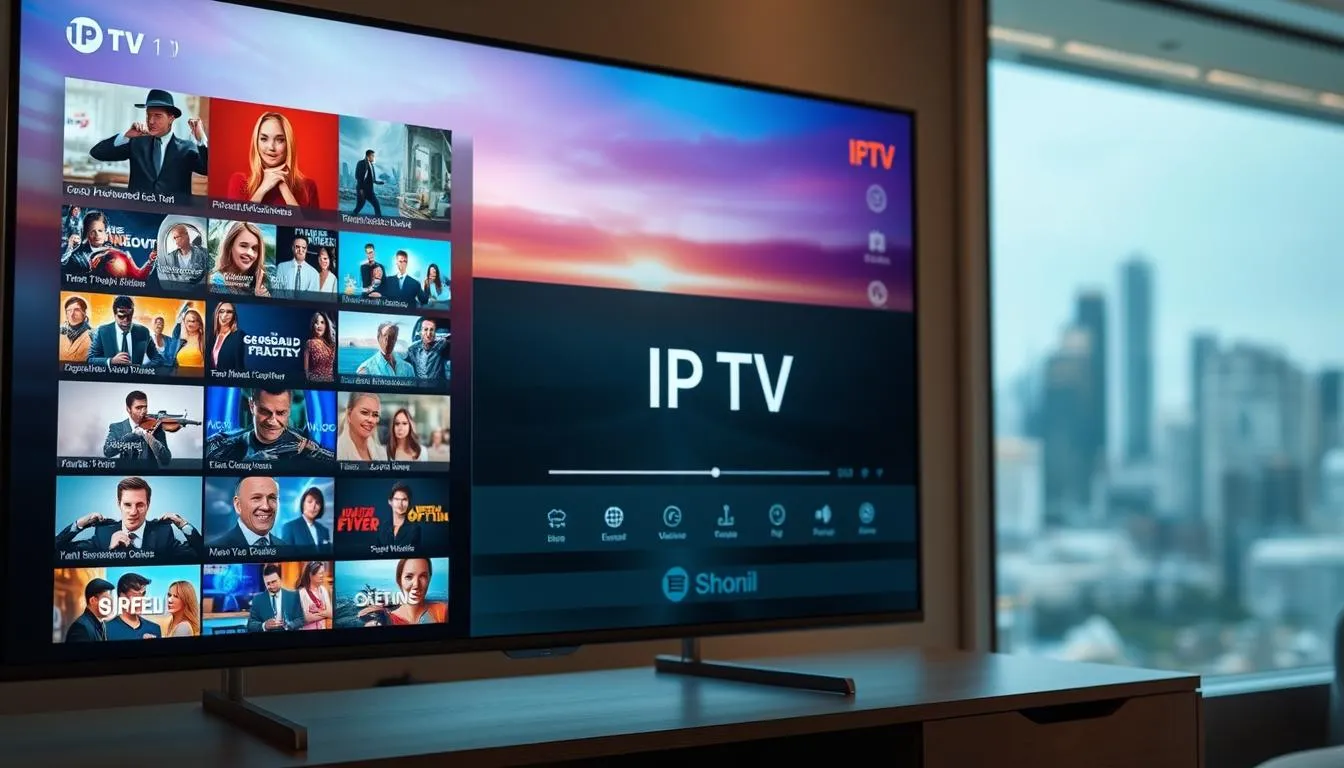Are you tired of traditional TV’s limits? Internet Protocol Television (IPTV) brings a new way to watch. It lets you stream your favorite shows over the internet. You get access to lots of channels and on-demand content.
IPTV has many perks, like high-quality video and flexible subscription options. You can watch your favorite shows on many devices. This makes it easy to enjoy entertainment anywhere, anytime.
Switching to IPTV means saying goodbye to old TV’s limits. Say hello to a better way to watch. Find out how IPTV can make your entertainment better.
What Is IPTV and How Does It Work?
IPTV stands for Internet Protocol Television. It’s a way to get TV content over the internet, unlike old TV methods. You can watch live TV, movies, and series on your internet connection.
The Technology Behind IPTV
IPTV uses a few key parts to bring TV content to your device. Knowing these parts helps you see how flexible and powerful IPTV is.
Protocol Basics and Data Transmission
IPTV uses internet protocols to send content. It sends data in packets for efficient delivery. Protocols like UDP (User Datagram Protocol) and TCP (Transmission Control Protocol) make sure data gets there right.
Server-Client Architecture
The IPTV service has a server-client architecture. Content is stored on servers and sent to devices when asked. This setup makes it easy to share content with many users.
Different Types of IPTV Services
IPTV services vary to meet different viewing needs. The main types are:
- Live Television Streaming
- Video on Demand (VOD)
- Time-Shifted Media
Live Television Streaming
Live TV streaming lets you watch your favorite channels live. It’s great for live events, news, and sports.
Video on Demand (VOD)
VOD services offer a huge library of movies, series, and documentaries. You can watch them whenever you want, pausing, rewinding, or fast-forwarding.
Time-Shifted Media
Time-shifted media, like catch-up TV, lets you watch shows you missed later. It’s perfect for catching up on programs you didn’t see live.
Here’s a quick look at the different IPTV services and what they offer:
| Service Type | Description | Key Features |
|---|---|---|
| Live TV Streaming | Watch live TV channels | Real-time viewing, live events |
| Video on Demand (VOD) | Access a library of content | Pause, rewind, fast-forward |
| Time-Shifted Media | Watch previously aired content | Catch-up TV, flexible viewing |

The Evolution of Television: From Cable to IPTV
IPTV is changing the TV world. It’s all about new tech and how we watch TV.
Traditional Broadcasting vs. IPTV
For years, cable TV has been the main way we watch shows. But, it has its downsides.
Limitations of Conventional Cable
Cable TV has limited channel options and rigid programming schedules. It also costs more because of bundled services. These issues have led people to look for other ways to watch TV.
Advantages of IP-Based Delivery
IPTV is different. It’s more flexible and affordable. You get on-demand content, personalized viewing experiences, and multi-device compatibility. This change is changing how we watch TV.

The Digital Revolution in Television
The digital revolution has changed TV technology a lot. There have been many important tech milestones.
Key Technological Milestones
New compression technology and high-speed internet make streaming better. These tech advances have made IPTV a good choice instead of cable.
Consumer Behavior Changes
How we watch TV has changed too. People want more flexibility and personalization. IPTV meets these needs with on-demand services and customizable channel packages.
Key Benefits of Using IPTV Services
IPTV services bring many benefits to your TV watching. They offer flexibility and variety. This is why many are choosing IPTV over traditional TV.
Cost-Effectiveness Compared to Cable
IPTV services are cheaper than cable TV. They have lower subscription costs. This makes them a good choice for those watching their budget.
Subscription Price Comparisons
Looking at IPTV and cable TV, IPTV is often cheaper. Their prices are more affordable than cable packages.
Hidden Cost Savings
IPTV also saves you money in other ways. You don’t have to pay for equipment rental. This cuts down your TV service costs even more.
On-Demand Content Accessibility
IPTV lets you watch shows and movies whenever you want. You don’t have to stick to a schedule.
Watch What You Want, When You Want
With IPTV, you can pick from a huge library of content. You can watch what you like, when you like. This is a big plus over traditional TV.
Content Library Diversity
IPTV has a wide range of TV shows, movies, and exclusive content. This variety means you can find something for every taste and preference.

Multi-Device Compatibility
IPTV works with many devices. You can stream your favorite content on different screens. This makes watching TV more flexible and convenient.
Streaming Across Different Screens
Whether it’s a smart TV, tablet, or smartphone, IPTV lets you stream without trouble. You can start watching on one device and pick up where you left off on another.
Simultaneous Viewing Options
Many IPTV services let you watch multiple streams at once. This is great for families. Everyone can watch their favorite shows at the same time.
Understanding IPTV Subscription Options
Getting to know your IPTV subscription options is key for a great viewing experience. There are many plans to choose from. You can pick the one that matches your watching habits and budget.
Monthly vs. Annual Subscription Plans
IPTV services have both monthly and annual plans. Your choice depends on how much you watch and your budget.
Cost Analysis and Savings
Annual plans usually have discounts, saving you money compared to monthly ones. For example, a yearly plan might save you up to 20%. But, think if you’ll keep watching all year.
Flexibility Considerations
Monthly plans offer flexibility. You can cancel or change your plan anytime. This is great if you’re not sure about watching long-term or want to try before you buy.
Free vs. Premium IPTV Services
Choosing between free and premium IPTV services is another big decision. Each has its own pros and cons.
Limitations of Free Services
Free IPTV services have limited content and may have ads. A study found that free services can be risky due to unverified content.
“Free services can be a gateway to piracy and malware.”
What Premium Subscriptions Offer
Premium IPTV subscriptions, however, have a vast library of content, high-quality streams, and extra features. For more on premium IPTV benefits, check out here.
The right IPTV subscription for you depends on your needs, watching habits, and budget. By looking at the pros and cons of each plan, you can choose wisely. This will improve your TV streaming experience.
The World of IPTV: Channels and Content
IPTV offers a wide range of channels, including international and niche content. This variety is a big draw, letting users find shows that match their interests. It’s a great way to explore different TV programming.
International Channel Availability
IPTV brings the world to your home with international channels. You can watch news, sports, and shows in languages from around the globe. It’s perfect for those who love to see what’s happening worldwide.
Regional Content Access
IPTV also has content tailored for specific areas. It’s great for local news, sports, and entertainment. This makes it easy to find shows that are relevant to your region.
Language Options and Subtitles
Many IPTV services offer content in different languages and with subtitles. This helps more people enjoy their favorite shows. It’s especially helpful for those who prefer watching in their native language or need help understanding different dialects.
Specialized Content Categories
Besides international channels, IPTV has specialized content. This includes sports packages, movie libraries, and channels for specific interests. It’s a great way to dive into your favorite topics.
Sports Packages
Sports fans will love the dedicated sports packages. They offer live games, analysis, and news. It’s a comprehensive way to follow your favorite sports.
Movie Libraries
Movie lovers will enjoy the vast movie libraries. You can find new releases and classic films. It’s a treasure trove for film enthusiasts.
Niche Interest Channels
Niche channels focus on specific hobbies or interests. They offer documentaries, cooking shows, and music. It’s a way to find content that really speaks to you.
Here’s a look at what different IPTV services offer:
| IPTV Service | International Channels | Sports Packages | Movie Libraries | Niche Interest Channels |
|---|---|---|---|---|
| Service A | 500+ | Yes | 10,000+ | 20+ |
| Service B | 300+ | Yes | 5,000+ | 15+ |
| Service C | 700+ | Yes | 15,000+ | 30+ |
Top IPTV Providers in 2023
The IPTV market in 2023 has a variety of services. You can find premium, mid-range, and budget-friendly options. Knowing the differences helps you choose the right one.
Premium Legal IPTV Services
Premium IPTV services offer top-notch content and reliable streaming. They have a wide range of channels. These services are perfect for those who want the best and are willing to pay for it.
Major Streaming Platforms
Big streaming platforms have joined the IPTV market. They offer their services through apps or set-top boxes. Some key players are:
- Netflix: Known for its original content, Netflix offers a variety of IPTV-compatible services.
- Amazon Prime Video: Amazon’s offering includes a vast library of content, including original series and movies.
- Hulu: Hulu provides a range of TV shows, movies, and documentaries, making it a popular choice.
These platforms are known for their high-quality streaming and easy-to-use interfaces.
Broadcaster-Owned IPTV Services
Broadcaster-owned IPTV services offer live TV and on-demand content directly from the broadcasters. Examples include:
- NBCUniversal’s Peacock: Offers a range of TV shows, movies, and original content.
- CBS All Access: Provides live TV and on-demand content from CBS.
These services are appealing because they offer content directly from the source. They focus on current and popular shows.
Best Value IPTV Providers
For those looking for a balance between cost and quality, best value IPTV providers are a good choice. These services offer a comprehensive viewing experience without the high costs of premium services.
Mid-Range Service Options
Mid-range IPTV services offer a good balance between price and content variety. Some notable services include:
- Sling TV: Offers customizable channel packages and on-demand content.
- YouTube TV: Provides a wide range of channels, including sports and news.
These services are popular for their flexibility and affordability.
Budget-Friendly Alternatives
For those on a tight budget, there are IPTV services that offer basic channel lineups at lower prices. Examples include:
- Philo: Offers a range of channels at an affordable price.
- Frndly TV: Provides a selection of family-friendly channels.
These services are ideal for viewers who want to keep costs low while still accessing their favorite channels.
Legal Considerations When Using IPTV
It’s important to know the legal side of IPTV for a smooth viewing experience. Knowing the legal rules helps you avoid trouble.
Copyright Laws and IPTV
Copyright laws are key in the IPTV world. IPTV services must follow these laws to stay legal.
Understanding Content Licensing
Content licensing is a big deal in IPTV. Licensing agreements let IPTV services show content legally. These deals are between content owners and IPTV providers.
Potential Risks of Unauthorized Services
Using unauthorized IPTV services can be risky. These services might break copyright laws. They could also harm your computer with malware.
How to Identify Legal IPTV Services
Finding legal IPTV services is key to avoiding legal trouble. Here are ways to check and what to watch out for.
Verification Methods
Legal IPTV services show their licenses and where they get their content. Look for services that are open about their licenses and content.
Red Flags to Watch For
Stay away from IPTV services that seem too cheap or don’t explain how they work. Bad signs include very low prices, no customer support, and unclear content licenses.
| Characteristics | Legal IPTV Services | Unauthorized IPTV Services |
|---|---|---|
| Licensing Agreements | Transparent and available | Lacking or unclear |
| Pricing | Competitive and reasonable | Unusually low |
| Customer Support | Available and responsive | Limited or unresponsive |
“The key to a safe and legal IPTV experience is diligence and awareness of the services you use.”
— IPTV Expert
Essential Hardware for the Best IPTV Experience
To enjoy seamless IPTV streaming, you need the right hardware. The quality of your viewing experience depends on your devices and network setup.
IPTV Boxes and Devices
IPTV boxes and devices are key for streaming content to your TV. They come in different forms, each with unique features and capabilities.
Android-Based Systems
Android-based IPTV boxes offer flexibility and customization. They support many apps and connect easily to your TV. Brands like Xiaomi and Nvidia are popular.
Apple TV Configuration
Apple TV is great for Apple fans. It offers a seamless viewing experience with high-quality video. To set up IPTV on Apple TV, install an app from the App Store.
Amazon Fire Devices
Amazon Fire TV devices are a popular choice for IPTV streaming. They are affordable and have Alexa integration for voice control. You can sideload IPTV apps using the Downloader app.
Network Requirements for Smooth Streaming
A strong network is key for uninterrupted IPTV streaming. Your internet connection and router affect your IPTV quality.
Internet Speed Recommendations
For smooth IPTV streaming, you need a certain internet speed. Here are some guidelines:
- SD (Standard Definition): 3 Mbps
- HD (High Definition): 5-8 Mbps
- Full HD: 10-15 Mbps
- 4K (Ultra HD): 25 Mbps or higher
Make sure your internet plan meets these requirements.
Router Specifications and Placement
Your router’s specs and placement affect your IPTV streaming quality. Use a dual-band or tri-band router to reduce interference. Place your router in a central location for even coverage.
Setting Up Your IPTV Service: Step-by-Step Guide
To enjoy seamless streaming, you need to set up your IPTV service correctly on your preferred device. This guide will walk you through the process. You’ll be able to start watching your favorite shows and movies without any hassle.
Installing IPTV on Smart TVs
Installing IPTV on smart TVs is easy. First, check if your TV is compatible with the IPTV service. Most modern smart TVs support IPTV, but it’s always a good idea to verify.
Samsung and LG TV Setup
For Samsung and LG TVs, find the IPTV app in the TV’s app store. Search for the IPTV service provider’s app, download, and install it. Once installed, launch the app, and follow the on-screen instructions to log in and start streaming.
Android TV Configuration
Android TVs offer more flexibility in terms of IPTV setup. You can install IPTV apps directly from the Google Play Store. Some IPTV services also provide APK files that can be sideloaded onto your Android TV. Ensure you follow the service provider’s instructions for a smooth setup.
Setting Up IPTV on Streaming Devices
Streaming devices like Firestick, Roku, and Chromecast are popular for IPTV streaming. Here’s how to set them up:
Firestick Installation Process
On a Firestick, install IPTV apps from the Amazon Appstore. Navigate to the app store, search for your IPTV service provider’s app, and install it. Some services may require you to enable “Apps from Unknown Sources” in the Firestick settings.
Roku and Chromecast Setup
For Roku, the process is similar; find the IPTV app in the Roku Channel Store, install it, and launch it. Chromecast users can use the Google Home app to cast IPTV content from their mobile devices to the TV.
Mobile Setup for On-the-Go Viewing
IPTV isn’t just limited to TVs; you can also enjoy it on your mobile devices. Here’s how to set it up:
iOS Application Installation
For iOS devices, visit the App Store, search for your IPTV service provider’s app, and download it. Some IPTV services have dedicated iOS apps that are easy to install and use.
Android App Configuration
Android users can find IPTV apps in the Google Play Store. Download and install the app, then follow the in-app instructions to set up your IPTV service.
| Device | Setup Process | Additional Notes |
|---|---|---|
| Smart TVs | Download IPTV app from TV’s app store | Check TV compatibility first |
| Firestick | Install IPTV app from Amazon Appstore | Enable “Apps from Unknown Sources” if necessary |
| Roku | Find IPTV app in Roku Channel Store | Simple installation process |
| Chromecast | Use Google Home app to cast IPTV content | Casting from mobile devices |
| Mobile Devices | Download IPTV app from App Store (iOS) or Google Play Store (Android) | Follow in-app instructions for setup |
Maximizing Your IPTV Streaming Quality
To get the best out of IPTV streaming, you need a strong internet connection and smart settings. Knowing what affects your IPTV streaming is key. This knowledge helps you make the most of your viewing experience.
Optimizing Your Internet Connection
A fast and stable internet is essential for smooth IPTV streaming. The connection type greatly affects your viewing quality.
Wired vs. Wireless Considerations
A wired Ethernet connection is more stable and less likely to have interference. It’s best to use a wired connection for your IPTV device. This reduces the chance of buffering and signal loss.
If you prefer wireless, make sure your Wi-Fi is set up right. Use the 5 GHz band for better performance and less congestion.
Bandwidth Allocation Techniques
Good bandwidth management is vital for IPTV streaming. Here’s how to allocate enough bandwidth:
- Limit devices connected to your network while streaming.
- Use Quality of Service (QoS) settings to prioritize IPTV traffic.
- Check your internet plan to meet IPTV speed requirements.
Video Quality Settings and Bandwidth Management
Adjusting video quality settings is crucial for a good IPTV streaming experience. It’s all about finding the right balance between video quality and available bandwidth.
Resolution and Bitrate Adjustments
Lowering the resolution or bitrate can help with buffering. Most IPTV services let you adjust these in their settings menu.
Buffer Size Configuration
Setting the buffer size right can help with network issues. A bigger buffer means a smoother stream but might add latency.
By optimizing your internet and IPTV settings, you can greatly improve your streaming quality. Keep checking your settings and connection for the best viewing experience.
Common IPTV Issues and Troubleshooting
IPTV users sometimes face problems that can be frustrating. But, most can be fixed with the right steps. Knowing how to solve these issues can make your streaming better.
Buffering Problems and Solutions
Buffering is a common problem for IPTV users. It can be due to internet issues, server overload, or hardware problems.
Identifying Buffering Causes
To solve buffering, find out why it’s happening. Check your internet speed; it should be at least 25 Mbps for HD content. Server overload and using Wi-Fi can also cause it.
Quick Fixes and Long-Term Solutions
Try restarting your IPTV app or device for quick help. For a lasting fix, upgrade your internet plan or get a better router. Also, keep your IPTV device’s software updated to avoid buffering.
Connection and Playback Issues
Other problems like connection and playback issues can also happen. These include authentication problems and stream instability.
Authentication Problems
Authentication issues often come from wrong login details or expired subscriptions. Double-check your username and password, and make sure your subscription is current. If problems continue, reach out to your IPTV provider’s support.
Stream Stability Improvements
For better stream stability, keep your device and IPTV app updated. A stable and fast internet connection is key. If using Wi-Fi, try moving your router closer or switch to Ethernet for better stability.
By tackling these common IPTV problems, you can have a smoother streaming experience. Regular updates and internet checks can prevent many issues.
The Future of IPTV Technology
The way we watch TV is changing fast with new IPTV tech. Many new trends are coming that will change the industry a lot.
Emerging Trends in IPTV
One big trend is using AI in IPTV. This means AI-enhanced content discovery. It makes TV shows and movies more personal by suggesting what you might like.
AI-Enhanced Content Discovery
AI looks at what you watch to find more shows you’ll like. This personalized approach makes watching TV more fun and engaging.
Interactive Viewing Features
Another trend is adding interactive features. This lets viewers get more involved with what they watch. You can vote, play quizzes, and more, making TV more exciting.
How 5G Will Transform IPTV Services
The arrival of 5G technology will change IPTV a lot. It will make mobile streaming better and video quality higher.
Mobile Streaming Advancements
5G makes mobile streaming fast and reliable. This means you can watch IPTV anywhere without interruptions. It’s great for those who watch TV on their phones.
Ultra-HD and 8K Streaming Potential
5G also means we can stream ultra-HD and 8K content. This will give viewers a movie-like experience at home. It’s a big step up in video quality.
| Trend | Description | Benefit |
|---|---|---|
| AI-enhanced Content Discovery | Personalized content recommendations | Enhanced user experience |
| Interactive Viewing Features | Incorporation of interactive elements | Increased viewer engagement |
| 5G Technology | Faster and more reliable mobile streaming | Improved streaming quality |
Conclusion
IPTV is changing how we watch TV. It offers a more personal, flexible, and affordable way compared to traditional TV.
It streams content straight to your devices over the internet. This marks a big change in TV watching. You get lots of channels and on-demand shows easily.
Key benefits include watching on different devices, saving money, and watching what you want. IPTV keeps getting better, bringing new features.
If you want to ditch old TV or try something new, IPTV is a great choice. With the right service and gear, you’ll open up a world of entertainment.
FAQ
What is IPTV and how does it differ from traditional TV?
IPTV, or Internet Protocol Television, delivers TV content over the internet. It’s different from traditional TV, which uses satellite or cable signals. You can watch IPTV on various devices with an internet connection, offering more flexibility than traditional TV.
How do I choose the best IPTV service for my needs?
To pick the best IPTV service, look at the variety of channels and content, pricing, and device compatibility. Also, check the streaming quality and any extra features like on-demand content and catch-up TV.
Can I watch IPTV on multiple devices simultaneously?
Yes, many IPTV services let you watch on multiple devices at once. Check with your provider to see how many devices you can stream on with your plan.
What internet speed do I need for smooth IPTV streaming?
For smooth streaming, you need at least 5 Mbps for SD content, 25 Mbps for HD, and 50 Mbps or more for full HD or 4K. Make sure your internet plan meets these speeds to avoid buffering.
Are there any legal considerations I should be aware of when using IPTV services?
Yes, using authorized IPTV services with the right licenses is key. Unauthorized services can lead to legal trouble due to copyright infringement. Always check if an IPTV service is legitimate before subscribing.
How can I troubleshoot common IPTV issues like buffering or poor video quality?
Start by checking your internet speed to ensure it meets the IPTV requirements. Try restarting your device or app, updating software, or lowering video quality settings.
Can I get a refund if I’m not satisfied with my IPTV service?
Refund policies differ among IPTV providers. Always read the terms and conditions before subscribing to know about refunds and cancellations if you’re not happy with the service.
What devices are compatible with IPTV services?
IPTV works on many devices, including smart TVs, streaming devices like Amazon Firestick, Roku, and Chromecast, and smartphones and tablets. Check with your provider for a list of supported devices.





